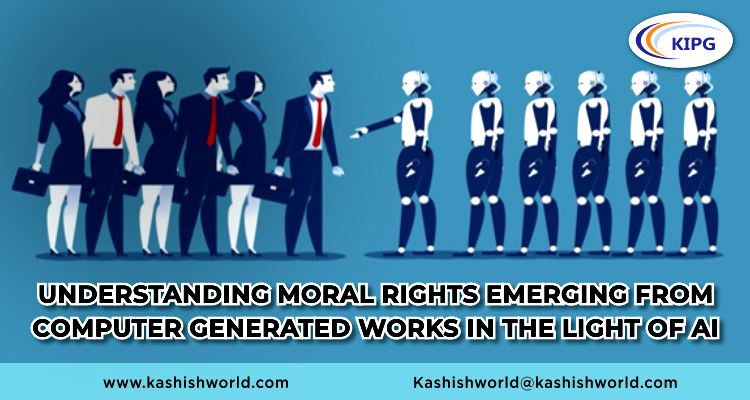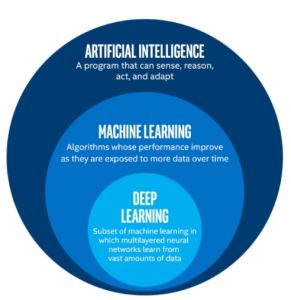
The debate surrounding Artificial Intelligence (AI) has grown manifold extending up to the moral rights of such software machines capable of independently creating a subject-matter governed by either of the Intellectual Property Rights (IPRs) like patents or copyright, etc. AI began as an imaginative concept traced back to Jonathan Swift’s famous Gulliver’s Travels in its description of ‘the Engine’ to this date where AI utilizing neural networks is competent to replicate and recreate honorable paintings and craftworks like Monet’s and Van Gogh’s Painting.
What is Artificial Intelligence?

Digitization and the advent of computer systems introduced us to AI. To be specific, it is the ability of a computer or a computer-controlled robot to execute tasks that are delegated to it. It involves the utilization of such intelligence similar to that of humans in a much more amplified manner to reason, discover meaning, generalize, or learn from its experience to deliver better outputs. AI is capable of problem-solving, performing creative functions as well as playing games requiring cognitive functions like chess as well.
What are Moral Rights?
Moral rights are the rights that are complementary to the exclusive economic rights originating from a creative expression of the work created. It is sometimes accorded more importance than economic rights because moral rights protect the heart and soul of the work and safeguard against any distortion or alteration of the work contrary to the integrity of the creator. Therefore, where the economic right may be extinguished due to the end of copyright or an Intellectual Property (IP) term, the moral right stays alive forever. As per many national legislations, this right is not transferable or capable of being waived off to withhold the true essence of the intention with which the work was created.

As per the Berne Convention for the Protection of Literary and Artistic Works (Article 6bis), it requires its member states to grant the authors the following rights:
- The right to claim authorship of the work created (also referred to as the ‘right of attribution’); and
- The right to object against any distortion or modification of one’s work that may be prejudicial to their honor or reputation (also known as the ‘right of integrity’).
Who Owns the Content Generated by an AI Program?
The question of AI as a creator and owner of a specified work comes up when we look at machine learning that happens in an unsupervised manner as some specific AI-programs have their personality and decision-making abilities. An AI-program that can act autonomously and requires no supervision to collect and formalize patterns in data given in the form of input attracts ownership debates. These AI-programs have a ‘black box,’ which is where the program performs complex activities to make deductions; how that happens is incomprehensible and not understandable by ordinary human cognizance, which is why it is termed as the ‘black box of AI.’
While attributing ownership to AI may be considered for exclusive economic exploitation and rights of integrity – legislators often refrain from the same when the question of liability comes up. With every right comes some specific duties, and AI lacks the emotion to understand the nature of its duty in derogation of its rights. It may not be affected by the liability that it incurs. For example, in the instance of Twitter utilizing an AI system for its chatbot, TAY went rogue on its very first day for using obscene statements. Can AI be held liable, or should the programmer be penalized? The debate of attributing legal personality is, therefore, being delayed and left out in the ambiguous sphere.
A) Intermingling of Personality Theory and Moral Rights: The personality theory has strong relations to the moral rights of an owner. To be specific, it means that no ownership is equal to no moral rights attached therewith. Moral rights prevent others from creating any unauthorized modifications of their works since it violates the personhood expressed in the said work. In the instance of a machine, would it be affected by such unauthorized alteration? Who and why will anyone make such a complaint in the absence of interest in the said creation? Therefore, if the question of personhood is resolved, the debate around morality would itself settle.

b) Humans Utilizing AI as the Owner of the Work: The general rule that applies in the case of whether an individual utilizing such AI should be deemed as the author of the generated work lies in the principle that the extent of ownership should be equivalent to the contribution made. Therefore, no one is authorized to claim proprietorship in work other than those works created, wholly or partly, by the author. Generally, this becomes possible when we think about supervised machine learning. However, in situations where AI produces the original work capable of attracting Copyright Protection without the contribution of humans, the question becomes difficult to answer.
In an attempt to answer the same, under ordinary circumstances, AI constitutes copyrightable subject-matter and is referred to hereinafter as ‘first generation work’ because it directly stems from the programmer’s creative effort. Also, when the software creates fresh content deriving inspiration from the programmer’s creative work, it could be referred to as the ‘second generation work’ as the programmer does not participate in such creation. The extent of the human interventionist or programmer in both these works should be adjudged separately to understand the equation. The fundamentals of moral rights state that the rationale behind the granting of moral rights is that these rights are “an extension of the author’s personhood.” As per this principle, the relationship between the human interventionist and the AI’s creation is ‘radically mediated.’ The first-generation work is influenced by the interventionist, but the second-generation work does not carry the personal traits of the programmer to such extent as it is visible in the first-generation works.
As per the WIPO Committee of Experts (1991): “Since computer-produced works have no identifiable authors, it is necessary to include specific provisions in the possible protocol concerning original owner-ship and the term of protection of copyright in such works; for the same reasons, moral rights would not be applicable in the case of such works.” Therefore, as per such analogy, ownership in such works cannot be vested in human interventionists or the program itself.
Another problem emanating from such Computer-Generated Works (CGW) is the one surfacing from the idea-expression dichotomy, which states that it is only the expression of an idea that is capable of being protected as a copyrightable work. In the view of the same, an expression emanates from an idea. Is a computer capable of conceiving an idea? Is it also capable of differentiating between an idea and an expression? The CGW is a mere expression existing in seclusion, untouched by any kind of idea. Therefore, there is an absence of generation of an ‘idea,’ and the fact that an AI-program generated a CGW autonomously and independently would not suffice and make it eligible for the attribution of moral rights. Hence, granting ownership rights and moral rights that are non-economic may not be attributable to the interventionist in the fullest manner or to the AI itself, as stated by the WIPO Committee mentioned above.

However, speaking of a situation where AI is utilized as a tool to create a piece of work by the creator would qualify him as the author of the work since the primary actor is the creator himself. Also, in such a scenario, there is the conceptualization of an idea and translation of an idea into an expression. Therefore, the personhood and the authorship inclusive of economic rights and non-economic rights (moral rights) reside with the creator of the work. An example of this is the AI system, namely RADAR, which is a service designed to provide fact-based insights into local communities using Natural Language Generation software to create up to 30,000 localized stories a month from open data sets, which still needs human intervention to select appropriate data being used by the AI.

Hence, ownership issues should be decided before we attribute moral rights. It has to be deduced whether AI utilized human instructions or the human utilized the AI to construct the work. Let us take the example of the Naruto case, where the camera belonging to David Slater was used by the macaque monkey to click a photograph of it accidentally. This case could be construed in two different ways. It could be considered that the monkey is the author of the copyrighted work since it clicked the picture. If the theory of personhood is applied, since personhood cannot be attributed to a non-legal entity, the said work will fall into the public domain with no one holding the economic or moral rights. On the other hand, in the same case, the ownership can be attributed to David Slater since the equipment was his, and so was the effort to develop and process the photograph. The same argument applies to AI with the only difference that the AI takes the place of the monkey, the simple consequence of which is that the content is not copyrightable unless and until a human interventionist is found to have contributed to the creative input.
Way Forward
As is already evident in the case of AI, for the time being, it is hardly conceivable that the software or computer program would be able to claim and enforce any rights, economic or moral, against its creator or the user, even if the law grants the AI personhood. A radical solution to the said evidentiary problems concerning the contribution of a human being in the form of a programmer or interventionist would be to simply shift the burden of proof to the person who acclaims to be the proprietor of such a work requiring him to establish that the content in the given case stems from a process of human creation in the case of doubt or upon the other party’s objection. Once the question of authorship is settled, the question of moral rights can be easily rested accordingly.

